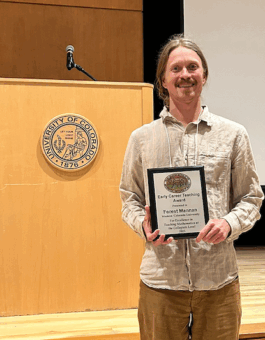The role wildfire plays in the sagebrush ecosystem may never be the same
GUNNISON, Colorado: The role wildfire plays in the sagebrush ecosystem is better and more widely understood now thanks to Petar Simic, a former Western Colorado University Master of Environmental Management student, and Habitat Restoration and Cheatgrass Coordinator for the Gunnison Basin, whose research on the subject was recently published in the journal Ecosphere.
According to Simic, the subject hasn’t been researched until now because it’s difficult to study since wildfires destroys so much of the sagebrush, which is then replaced by new growth, that there’s very little record of the fire once it goes out.
Also, he said, “there is a general lack of interest in the sagebrush steppe, despite the sagebrush steppe being the most widespread ecosystem in the United States and being home to hundreds of obligate species. Historically, sagebrush has been considered a nuisance species that needed to be eradicated and replaced with grasslands for livestock grazing. That notion has persisted culturally.”

Simic, along with co-authors Jonathan Coop, who is the Master of Science in Ecology program director and a professor of environment and sustainability at Western, and the University’s provost, Jess Young, reconstructed the fire histories of several sites in the Upper Gunnison Basin using data from tree ring fire scars. The goal was to learn what they could about the effects fire has in the sagebrush steppe, and if the fire cycle changed following European settlement.
What they found was that in the 200 years before widespread European settlement in the West, until 1892, low-intensity fires burned early in the growing season in areas of the sagebrush ecosystems about every 50 years on average.
But according to Simic’s research, after 1892, wildfire was almost completely eliminated from the landscape for over 100 years as cattle grazing removed much of the grass that served as a main ignition fuel for fires alongside a change in land use, toward development and resource extraction, which led to efforts to put out all the fires that started.
“Another hypothesis is that the Ute people used fire to maintain forage for big game, which they would hunt in the summers. With the removal of the Ute people in the late 1800s came the removal of ignition sources that may have helped maintain the historical fire regime,” Simic said. Then, slowly, prescribed burning started to return in a few places around the turn of the 21st century, but in a vastly altered ecosystem.

After the prescribed burns, grasses and forbs including many non-native varieties, grew fast and tall while sagebrush and woody plants like it took a long time to regrow. The research showed that because of the changes in vegetation, the low-intensity, high-frequency fires that were once present on the landscape were replaced by high-intensity, low-frequency fires that tend to be more destructive. Changes like that can have a significant impact on the species adapted to the sagebrush ecosystem like the endemic Gunnison Sage Grouse, which was listed as threatened under the Endangered Species Act in 2014.
The work took Simic about three years to accomplish, from the time he started the research to the publication of his paper in June. He hopes his careful study will lead land managers to make fewer assumptions about the effects fire has on the ecosystem and the ability of the Gunnison Sage-grouse to survive occasional, low-intensity burns if such a burn can return to the landscape. “The scientific method should guide best land management practices,” he says.
To learn more about Western’s Master in Environmental Management (MEM) program, visit western.edu.
About Western Colorado University: Established in 1901, Western is a four-year public institution in Gunnison, Colo. that offers undergraduate and graduate programs in over 100 areas of study. Our campus on the Western Slope of the Rocky Mountains is home to more than 2,000 resident students, while approximately 1,600 additional students take courses at the University remotely.


